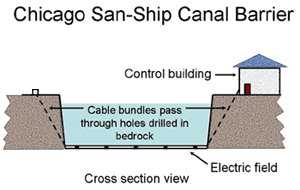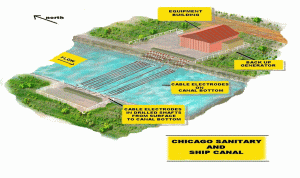 As long as the Great Lakes and Mississippi basins remain connected by Chicago’s canal system, invasive species like Asian Carp and zebra mussels will continue to spread between the watersheds. While Prairie Rivers Network continues to press for a permanent solution, Asian carp keep swimming closer to Lake Michigan and the electric fence in the Sanitary and Ship Canal remains the last line of defense. Unfortunately it seems like every time the Army Corps of Engineers makes hardware or operational upgrades, scientists discover new “holes” in the fence.
As long as the Great Lakes and Mississippi basins remain connected by Chicago’s canal system, invasive species like Asian Carp and zebra mussels will continue to spread between the watersheds. While Prairie Rivers Network continues to press for a permanent solution, Asian carp keep swimming closer to Lake Michigan and the electric fence in the Sanitary and Ship Canal remains the last line of defense. Unfortunately it seems like every time the Army Corps of Engineers makes hardware or operational upgrades, scientists discover new “holes” in the fence.
Only after being threatened with a lawsuit by Prairie Rivers Network and the NRDC, the Army Corps of Engineers reluctantly released a 9-month old report that it intended to keep under wraps for at least 6 more months. The report by Smith-Root Inc. raises serious concerns about whether the electric fences are capable of preventing small Asian Carp from reaching Lake Michigan through Chicago’s Sanitary and Ship Canal. More troubling is the accompanying memorandum from the Corps, explaining its failure to act sooner on the results by increasing the operating voltage.
These laboratory experiments were needed because it is known that big fish receive strong shocks from the electric field, while small fish receive weaker shocks. The report revealed that the Corps knew as early as April 2009 (while operating the electric fence at only 25% of full strength) that such a low operating voltage was inadequate to immobilize small silver carp under controlled conditions in the lab. Instead of making the results public and increasing the operating voltage immediately, they continued to operate at 25%. Months later when researchers from Notre Dame and the Nature Conservancy tested the waters for DNA, they found that the Asian Carp invasion front had advanced to the Brandon Road Pool, immediately downstream of the Lockport Pool where the electric fence is located. Only then did the Corps increase voltage from quarter to half-strength, the level shown to repel silver carp in the laboratory experiments.
Additional experiments during fall 2009 showed that even higher voltages were needed to repel small bighead carp, the other species of Asian carp threatening to invade the Great Lakes via the canal. Again the Corps failed to release the results, and failed to increase the voltage. Subsequent experiments during spring 2010 uncovered even more causes for concern: schools of fish penetrated the electric field more aggressively and successfully than the individual fish tested earlier; water in the canal occasionally reverses direction, raising the possibility that a fish temporarily stunned while crossing the electric fence would float towards Lake Michigan instead of away from it; and road salt from city streets increased the conductivity of the canal water, requiring massive increases in electric power to maintain a strong electric field.
The cover memorandum from the Corps did not address all the deficiencies identified in the contractor’s report. Instead it defended the decision to continue operating the fence at half-strength because it believes the nearest population of small Asian carp is at least 25 miles downstream, and not in a position to challenge the electric fence “at this time.” It explained how difficult it might be for small fish to swim so far upstream, but failed to mention how easy it might be to hitch a ride in the ruptured ballast tanks of barges and towboats travelling daily towards Chicago. The memo also cited safety concerns about increasing the voltage to levels shown to immobilize small bighead carp (sparking on barges carrying flammable or explosive cargo; electrical shocks to boaters). However it gave no reason for waiting more than a year (December 2009 to February 2011) before conducting higher-voltage safety tests at the electric fence.
The Corps’ statement concludes by stating that it “intends to adjust the operating parameters if evidence indicates that very small silver or bighead carp migrate closer to the electric barrier, once a full understanding of safety and maintenance implications is achieved.” It is another race against time: The Corps needs to figure out how to increase the voltage safely before the carp arrive.
Prairie Rivers Network is focused on the long-term solution of permanently separating the basins and replacing Chicago’s antiquated 19th century transportation, sewage and stormwater systems with 21st century sustainable technology. In the meantime, Congress needs to give the Corps the support it needs to keep plugging the the holes in its electric fence.








